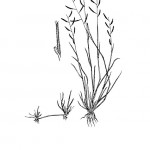Black Grama
Bouteloua eriopoda (Torr.) Torr.
Poaceae
Description
The Black Grama’s most distinctive features are its stolons, woolly internodes, and spikelets which appear black from a distance. The weak, crooked, slender, woolly stems often take root at the swollen, fuzzy joints. A plant has about six to nine densely woolly-pubescent stolons. Its stem wool is usually confined to the lower half of the internodes. Its sheaths are much shorter than its internodes. The internodes usually stay green during winter. The inconspicuous leaves are narrow, 1 to 2 mm, and tend to roll inward giving a thread-like appearance. New leaves tend to emerge from buds on the stolons and the base of the culms. The seed head has three to eight widely spaced spikes which are very woolly at their base and carry 18 to 20 loosely spaced spikelets. The spikelets are three-awned, and young inflorescences from a distance look black. Black Grama is a perennial, warm-season, native reaching up to 2 ft or 60 cm tall. It is a good source of vitamin A during winter. It is a choice forage grass and so highly palatable it decreases with heavy grazing. It can typically only be found where it has been protected by shrubs and cacti from grazing. It is also good forage for wildlife.Habitat
Black Grama grows on gravelly uplands, dry slopes, and plains. It seldom grows on clay loams. During mild, moist winters its lower stems can stay green all winter.Images
Plant Characteristics
Duration: Perennial
Stem Texture: Hairy
Growth Habit: Bunch grass, Grasses
Season: Warm
Distribution
 : 03 - Post Oak Savannah, 04 - Blackland Prairies, 06 - South Texas Plains, 07 - Edwards Plateau, 08 - Rolling Plains, 09 - High Plains, 10 - Trans-Pecos
: 03 - Post Oak Savannah, 04 - Blackland Prairies, 06 - South Texas Plains, 07 - Edwards Plateau, 08 - Rolling Plains, 09 - High Plains, 10 - Trans-Pecos
Distributions
Distribution refers to the ecological region in Texas that a plant has been found. You can also view a clickable map.
Book: Know Your Grasses (B-182)
Collection: Grasses


